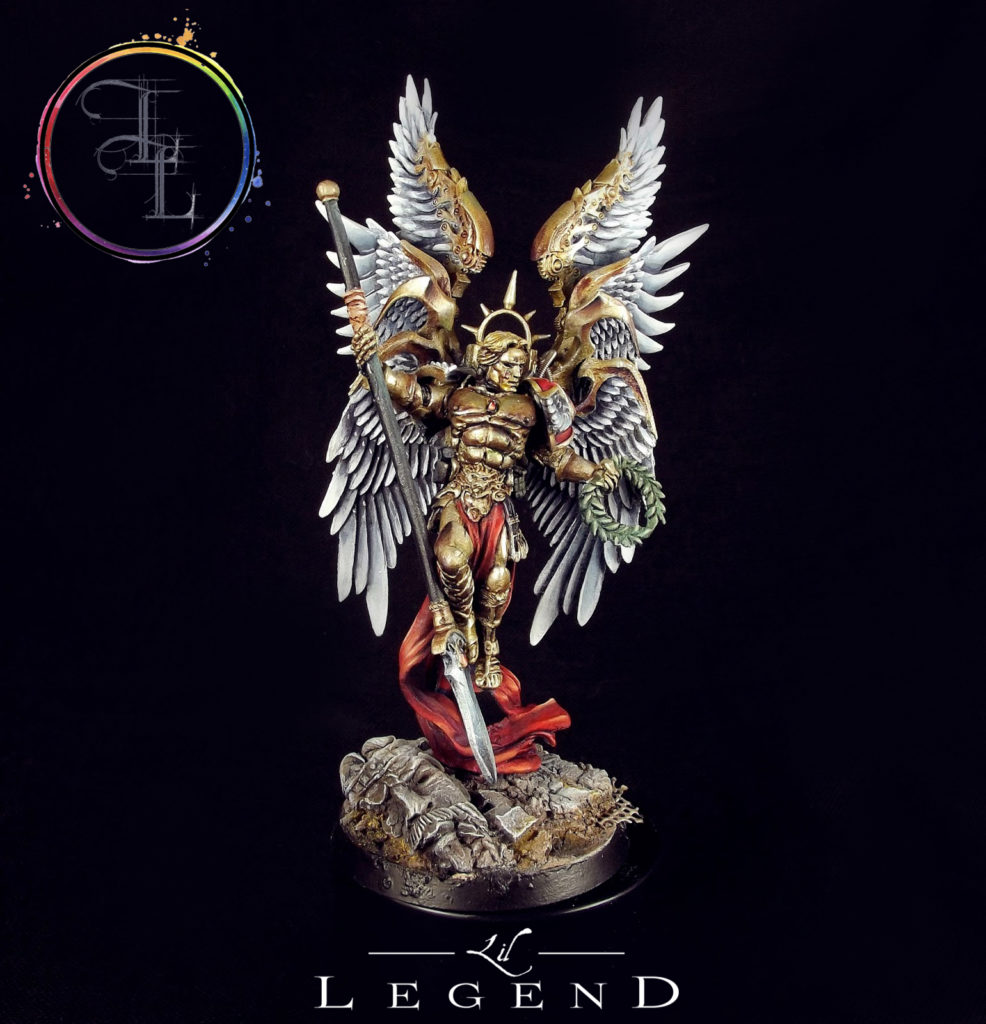
I wrote this article 2010 about the thoughts behind the construction of Lucifer. Enjoy!
How many Wings does a Seraphim Have?
Lucifer came about as a reaction to seeing the Sanguinor model for the first time. Like many of you reading this, my jaw just hit the floor. What a sculpt, and what a paint job. Seeing the accompanying range GW were planning, and the shift in emphasis from ‘Cyber punk- renaissance’ (see earlier post) to a more angelic characterization, I knew that I had to convert something special.
With such a wealth of paintings, imagery, and text devoted to the subject of angels, I thought it would be remiss of me not to have a casual glance over the subject.
Everybody knows what an Angel is, but I doubt when asked, that any two people’s definition is ever the same. The word Angel is a fusion of the old French angele, and Old Enlglish word engel. Both derive from the latin angelus, a romanizaion of the ancient greek word angelos, which means messenger. Most religions have winged deities, or angels, although their function is always on behalf of a higher power. Messengers of eternal truth, or power.
Descriptions of Angels are quite bizzare. For example, the Pseudo-Dionysius the Areopagite, in his Celestial Hierarchy fixed the image of a fiery Seraphim into medieval imagination. It is here that the Seraphim are described as being concerned with keeping Divinity in perfect order, and not limited to chanting the trisagion. Taking his cue from writings in the Rabbinic tradition, the author gave an etymology for the Seraphim as “those who kindle or make hot”:
“The name seraphim clearly indicates their ceaseless and eternal revolution about Divine Principles, their heat and keenness, the exuberance of their intense, perpetual, tireless activity, and their elevative and energetic assimilation of those below, kindling them and firing them to their own heat, and wholly purifying them by a burning and all-consuming flame; and by the unhidden, unquenchable, changeless, radiant and enlightening power, dispelling and destroying the shadows of darkness”

In classical and Christian mythology (is it cool to call an official religion mythology?), the higher classification of Angels had more than one set of wings.
Seraphim – have six wings; two covering their faces, two covering their bodies, and two with which they fly.
Cherubim – have four faces: one of each a man, an ox, a lion, and an eagle.
Thrones, or Ophanim– are beyl-colored wheel-within-a-wheel, their rims covered with hundreds of eyes (sounds quite chaotic no?).
Dominions are divinely beautiful humans with wings, and occasionally wield orbs of light fastened to the pommel of their swords.
Virtues are often presented in choirs.
Powers or Authorities are the warriors and have the distinction that none of their orders has ever fallen from grace.
Principalities or Rulers – are shown wearing a crown and carry a scepter.
Archangels – The most commonly depicted class of Angel. Michael belongs to this ruling class.
Angels – The messengers to mankind. Humans with wings.

I knew, even before reading these descriptions, that Lucifer would be modeled with more than one set of wings. I have also read that when Seraphim open their wings other beings, not even other orders of angels, can bear to stand in their presence. I’d imagine that Lucifer in full golden plate, feet never touching the ground as he makes war with the foe, would be a decimating sight.
Since the renaissance, Angelic imagery has become less obsessed with reflecting an immaterial, spiritual realm, but rather more concerned with visual metaphor. The lance, or spear for example, symbolic of truth, order, knowledge. Lucifer, brandishing a spear in one hand, and a wreath in another, becomes less of a literal, photo-like translation of a Blood Angel commander looks like mid-battle but instead becomes more a sculpture, concerned with the visual metaphor of his weaponry. Throughout the army, I have modeled fallen statues, plinths, and signs of a fallen civilization on the bases. On Lucifer’s base, he ascends over the shattered head of a god, cast down by Astrates whose aim had been to abolish false Gods. If you look at the fluff throughout this blog, you will notice the timeline – just after the Heresy. I imagine that some remnants of the original crusading Astrates would be left within the Chapter’s ranks. Marines who remember the original tenants of the imperial truth, who see the emergence of the Ecclesiarchy, and the stripping away of power by the hands of new organizations like the Inquisition. When modeling the fallen statues, I had Shelley’s Ozymandias in mind:
"I met a traveller from an antique land
Who said: "Two vast and trunkless legs of stone
Stand in the desert. Near them on the sand,
Half sunk, a shattered visage lies, whose frown
And wrinkled lip and sneer of cold command
Tell that its sculptor well those passions read
Which yet survive, stamped on these lifeless things,
The hand that mocked them and the heart that fed.
And on the pedestal these words appear:
`My name is Ozymandias, King of Kings:
Look on my works, ye mighty, and despair!'
Nothing beside remains. Round the decay
Of that colossal wreck, boundless and bare,
The lone and level sands stretch far away".

The shattered civilization on Lucifer’s base is a visual joke. The artist who made the statue of the god must have thought it would stand forever, just as Lucifer’s hubris fuels his belief that the Imperium will stand forever, even as it stands of the brink of shattering completely. Conversely, even as I made the model I did not think of where it will be in thirty, forty, even a hundred years time.

The army really started with Lucifer in mind, I just had to wait until I could build my vision. For all of those out there who think magnets are the be all and end all of easy customization – think again. Magnets will make you kick your cat (or next door’s if you don’t have one), drive you to drink, fight walls (I have a penchant for attacking my thin balsa wood door when I’m in a mood; feel well hard when I put a hole in it), and think hard whether it’s all worth it or not. But if you get over this, hey, you will have a cool model, that can change bases, is easy to store, and easy to travel with.


